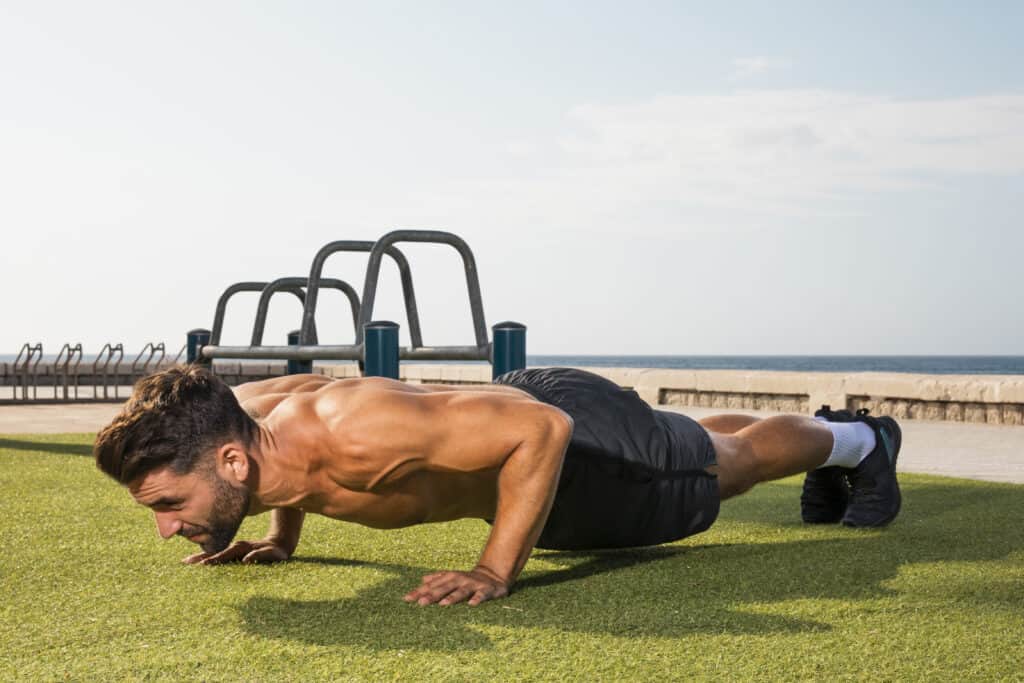Push-ups are an ideal exercise because of their versatility and the fact that the exercise itself is a compound movement. You can build muscular strength or endurance (depending on the routine) in the chest, shoulders and arms, even though it’s only a bodyweight exercise. Did you know that you use about 65 percent of your bodyweight when performing the exercise? That number can also increase depending on how you position the body, especially the legs. Here is a quick breakdown of some common push-up variations to try.
Amount of Bodyweight Lifted During Push-Up Variations
- Kneeling Push-Up – 49 percent of your weight is pressed with knees are on the ground
- Elevated Push-Up – 55 percent when the hands are elevated 22.5 inches
- Standard Push-Up – 64 percent of bodyweight is pressed
- Feet Elevated Push-up – 70 percent – when the feet are elevated 12 inches.
- Feet Elevated Push-up – 74 percent – when feet are elevated 23.5 inches
Push-Up Progression
When the standard push-up becomes easier to execute over time, add one of these four push-up variations to your routine. Change things up every few weeks or monthly depending on how much you want to be challenged and your individual needs and goals. Begin with the first and slowly progress to the fourth exercise.
1. Single-Leg Push-Up
How to Perform (progress to this exercise from a standard push-up).
1.) Begin by getting yourself into a push-up position with arms shoulder width apart and feet extended behind you with toes flat on the floor. Make sure the wrists are positioned directly below the shoulders for this and all variations.
2.) Take one leg and place it over the other so that only one foot is positioned on the floor.
3.) Slowly lower yourself down until your chest almost touches the floor then hold for a count.
4.) Return back to the starting position.
5.) Repeat for as many reps and sets as desired.
2. Elevated Push-Up
How to Perform (progress to this exercise following a standard push-up or push-up to side plank, not shown here).
1.) Start in a push-up position with a flat bench positioned behind your feet.
2.) Elevate your feet and place them either in the middle of the bench or at the edge of it (depending on the position of the bench) so that your body is elevated off of the floor.
3.) Slowly lower yourself down towards the ground until your chest almost touches the floor and you feel tension in your muscles.
4.) Hold this position for a second then return back to the starting position, pushing up with your pecs and squeezing your chest on the way up.
5.) Repeat for as many reps and sets as desired.
3. Plyo Push-Up
How to Perform (progress to this exercise after doing an elevated push-up).
1.) Start in a prone push up position on the floor with your arms fully extended at shoulder width and keeping your body straight.
2.) Slowly descend to the ground by flexing through your elbows, lowering your chest towards the ground until you feel a tension in your chest.
3.) As soon as you feel a stretch in your muscle quickly push yourself back up so that your hands leave the ground.
4.) Return back to the starting position and repeat for as many reps and sets as desired.
4. Clap Push-Up
How to Perform (progress after performing a clap push-up).
1.) Start by getting into a push-up position, keeping your legs extended and toes on the floor behind you.
2.) Perform a forceful push-up so that you have enough momentum and strength to bring your hands up off of the floor.
3.) While you are elevated off of the floor, clap your hands together and land back on your hands shoulder width apart.
4.) Repeat for as many reps and sets as desired.
Final Thoughts
The idea behind this example, of our four exercise push-up progression, is to perform each exercise for a few weeks or months before transitioning to the next exercise. The last two exercises are the most difficult, so begin with low volume (sets and repetitions). As you become stronger, you can increase the volume of work.
Stay Strong Together
Try the award-winning Jefit app for your next workout. Take advantage of Jefit’s exercise database for planning & tracking your strength workouts. Named best app for 2022 and 2023 by PC Magazine, Men’s Health, The Manual, the Greatist and many others. The app comes equipped with a customizable workout planner and training log. The app also has ability to track data, offer audio cues, and has a feature to share workouts with friends. Visit our members-only Facebook group. Connect with like-minded people, share tips, and advice to help get closer to reaching your fitness goals. Try one of the new interval-based workouts and add it to your weekly training schedule.
- The New Rules of Strength Training in 2026 - December 24, 2025
- Fibermaxxing: Viral Nutrition Trend You Should Know - December 17, 2025
- Hybrid Metabolic Strength Training for Faster Results - December 10, 2025
